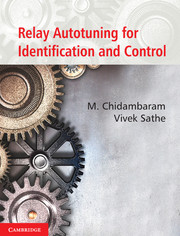Book contents
- Frontmatter
- Contents
- List of Figures
- List of Tables
- Acknowledgements
- Preface
- 1 Introduction
- 2 Improved Autotune Identification Methods
- 3 Cascade Controllers Tuning by Relay Autotune Method
- 4 Simultaneous Relay Autotuning of Cascade Controllers
- 5 A Simple Method of Tuning Cascade Controllers
- 6 Improved Saturation Relay Test for Systems with Large Dead Time
- 7 Identification of FOPTD Model using Single Symmetrical Relay Test
- 8 Autotuning of PID Controllers for Unstable FOPTD Systems
- 9 Autotuning of PID Controllers for Critically Damped SOPTD Systems
- 10 Estimation of SOPTD Transfer Function Model
- 11 Estimation of Five Parameters of Unstable SOPTD Model with a Zero
- 12 Identification of FOPTD Multivariable Systems
- 13 Identification of SOPTD Multivariable Systems
- 14 Tuning of Multivariable Controllers for Non-Minimum Phase Systems
- 15 Tuning of Multivariable Controllers by Genetic Algorithms
- 16 Summary and Conclusions
- Appendix A
- Appendix B
- Appendix C
- Nomenclature
- Problems
- Suggestive Reading
- References
- Index
6 - Improved Saturation Relay Test for Systems with Large Dead Time
Published online by Cambridge University Press: 05 June 2014
- Frontmatter
- Contents
- List of Figures
- List of Tables
- Acknowledgements
- Preface
- 1 Introduction
- 2 Improved Autotune Identification Methods
- 3 Cascade Controllers Tuning by Relay Autotune Method
- 4 Simultaneous Relay Autotuning of Cascade Controllers
- 5 A Simple Method of Tuning Cascade Controllers
- 6 Improved Saturation Relay Test for Systems with Large Dead Time
- 7 Identification of FOPTD Model using Single Symmetrical Relay Test
- 8 Autotuning of PID Controllers for Unstable FOPTD Systems
- 9 Autotuning of PID Controllers for Critically Damped SOPTD Systems
- 10 Estimation of SOPTD Transfer Function Model
- 11 Estimation of Five Parameters of Unstable SOPTD Model with a Zero
- 12 Identification of FOPTD Multivariable Systems
- 13 Identification of SOPTD Multivariable Systems
- 14 Tuning of Multivariable Controllers for Non-Minimum Phase Systems
- 15 Tuning of Multivariable Controllers by Genetic Algorithms
- 16 Summary and Conclusions
- Appendix A
- Appendix B
- Appendix C
- Nomenclature
- Problems
- Suggestive Reading
- References
- Index
Summary
Yu (1999) introduced the saturation relay feedback test for determining the ultimate gain and ultimate frequency of the system that are required for the design of PI/PID controllers. In the present chapter, two modifications are proposed to improve the efficiency of the saturation relay feedback test, especially for systems with a large dead time. In the first method, the safety factor is corrected based on the ideal relay feedback test. In the second method, higher order harmonics are included in the analysis of ideal relay. Simulation results are given to show the improvement of the proposed method over that of the Yu (1999) method for an FOPTD system and for a higher order system. The method is also compared with that proposed by Luyben (2001) for identifying the FOPTD model parameters.
Introduction
Li et al. (1991) pointed out that the error in estimation of ultimate gain ranges from -18% to +27% (with respect to the theoretical value) in ideal relay feedback test. To reduce the error in the estimation of ultimate gain, Yu (1999) suggested the saturation relay feedback test. In this method, the ultimate gain estimated from the ideal relay feedback test is multiplied with a safety factor to get slope of the saturation relay and the saturation relay feedback test is conducted to get better results for the ultimate gain and frequency.
The method proposed by Yu (1999) gave accurate results for small D/τ ratio (generally D/τ < 2).
- Type
- Chapter
- Information
- Relay Autotuning for Identification and Control , pp. 79 - 92Publisher: Cambridge University PressPrint publication year: 2014

